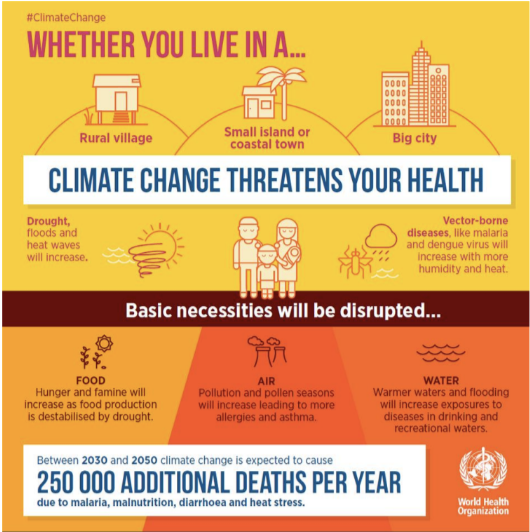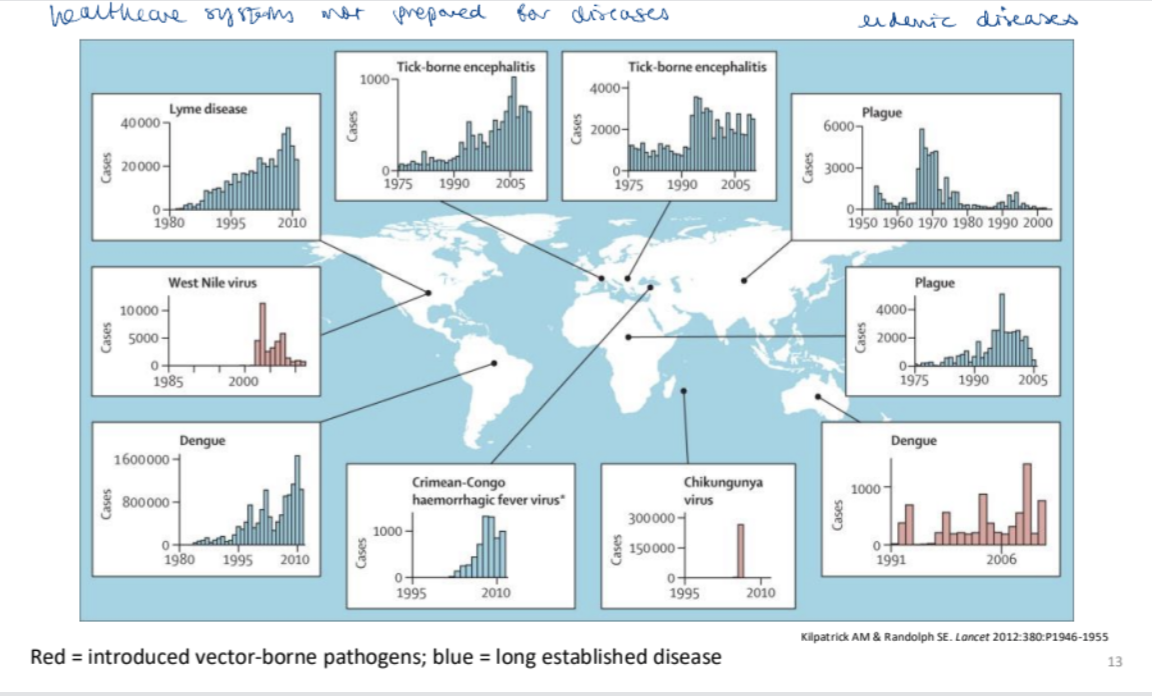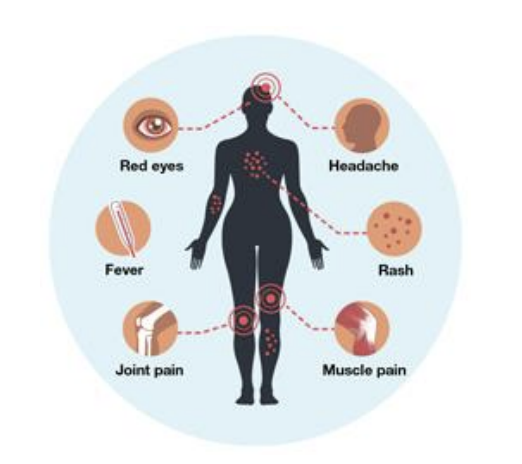Climate change general
1/23
Earn XP
Description and Tags
LOs: Overview of how climate change affects human health • Changes to vector-borne disease • Effects of extreme events on human health • Changes to water-borne disease
Name | Mastery | Learn | Test | Matching | Spaced |
|---|
No study sessions yet.
24 Terms
What are syndemics? (3)
Closely interrelated complex of health and social crises (interplay between biological and contextual factors) - substance abuse/violence/AIDs
Clustering of two or more health conditions
Biological interactions among the health conditions that lead to an increased health burden in the affected population
Adverse contextual factors - e.g., poverty, violence, limited access to care – facilitate the clustering of some health conditions and worsen their pathogenesis and treatment efficacy
Social inequalities drive disease interaction
What is global syndemic?
Obesity, undernutrition, climate change, vulnerability
Affects business models, food systems, civil society involvement, national and international governance

Warmest year on record
2024
List effects of climate change on human health
Respiratory disease: air pollution, pollen and other allergens
Food shortages, malnutrition and undernutrition (eg from flood wiping out crops)
Mental illness
Vector borne disease
Water borne illness
Extreme events
Temperature related morbidity and mortality
Ecoanxiety (anxious abt state of environment)

Climate change vulnerabilities
Vulnerability factors
Exposure pathways
Health system capacity and resilience
Vulnerabilites differ based off geography

Vector-borne diseases
Rats, fleas, mosquitoes and ticks
Carry pathogen from one host to the next bringing disease with them
Heat and moisture provide ideal breeding conditions and improve survival
Faster replication time of some pathogens
Global warming means wider distribution
What are endemic diseases?
Examples of long-established diseases
Diseases that are consistently present within a specific geographic area or population. They occur at a stable, predictable rate over time, unlike epidemics or pandemics which involve sudden spikes in cases

List examples of vector-borne diseases and vectors
Zika virus
Malaria
Ticks
Bats
Zoonotic diseases
Zika virus
Which weather does it flourish in and 3 reasons why
Hot weather:
Heat makes mosquitoes hungrier
Warm air incubates virus faster
Territory expands to new areas
First detected in Africa (1940s), then spread to NE Brazil
Zika virus
Symptoms (8)
First identified when and how many infections now in 2016 Americas
How will its prevalence increase?
Congenital effects and foetus effects
1947 in rhesus monkey in Zika forest, Uganda
4 million in Americas 2016
Will increase with climate change

Zika virus
Congenital and foetal effects
Transmission (3)
Maternal clinical symptoms (4)
Possible clinical consequences (4)
Mechanisms of fetal infection (4)
Mechanisms of microcephaly and CNS abnormalities (2)
Highest risk of birth defects is from Zika virus during 1st and 2nd trimester
Can be asymptomatic (4.2%)
Birth defect rate similar with/without symptoms – lab confirmed infection

How is climate change expected to affect malaria patterns globally? (4)
Climate change is increasing global climate suitability for malaria transmission, especially in new regions
Due to rising temperatures and changing precipitation patterns, which expand the habitable range of Anopheles mosquitoes (malaria vectors).
→ Global net increase in the population at risk, particularly from the 2050s onward.
Areas currently unaffected (e.g., parts of Europe, Asia, and the Americas) may begin to see malaria emergence due to vector spread into warmer regions.
Climate change creates new ecological niches for vector-borne diseases
How are zoonotic diseases transmitted?
Zoonotic diseases are transmitted from animals to humans via direct or indirect contact, through several routes:
(Vector-borne transmission: via insects like mosquitoes or ticks.
Air-borne / water-borne: inhalation or ingestion of contaminated particles.
Direct contact: touching or handling infected animals.
Indirect contact: exposure to environments contaminated with animal waste (e.g. bird droppings).
Food-borne transmission: consuming infected animal products.
Intermediate hosts: animals like camels, civet cats, or pangolins may carry viruses that jump to humans.
Viral mutation: enables the virus to adapt and spread between humans, as seen in SARS-CoV and SARS-CoV-2.)
Injuries from extreme events (4)
Fires, floods, rising sea levels
Bushfires - (increased frequency, intensity, duration of bushfires in the world, costs the US $1.7)
Affects food chain
Fires – risk of being burned or of smoke inhalation
Air quality affected: (eg smoke ploumbs) particulates entering body → respiratory tract, CV system → CVDs, respiratory diseases
(Air quality affected even in areas not affected by bushfire)
Flooding – drowning and changes terrain introducing hazards
Effects of bushfire on aquatic wildlife and food chain (6)
Direct asphyxiation of fish – gills clogged with ash
Bacteria grow in water – deoxygenation of water and kills fish
Changes pH of the water
Disrupts breeding habitats
Prevent/promote phytoplankton growth (base of aquatic food chains, effects fish ecosystem)
Tainted drinking water supplies:
Contamination of freshwater reservoirs reduces safe water for agriculture and livestock, compounding food production issues, reducing food availability for us
What can air pollution come from?
Components of air pollution (3)
Man-made examples
Natural examples
Components of air pollution: Gases (e.g. CO₂, NOx, SO₂) chemicals, particulate matter
PM₂.₅: combustion particles, metals, organic compounds
PM₁₀: dust, pollen, mould
Man-made: indoor environment (eg cleaning products), cooking, factories, vehicle emissions, construction + demolition
Natural: volcanoes, bushfires, pollens, spores, dust storms
(7 million premature deaths each year due to the bad quality of the air we breathe (WHO))
Short (5) and long-term effects (3) of air pollution on health

Biological effects of air pollution (7)

How Does Climate Change Affect Water and Health?
Changes in water temperature
→ Especially in oceans; alters ability of organisms to grow, survive, and thrive
→ Affects species distributions and ecosystemsDroughts, floods, and fires
→ Impact water availability and quality
→ Increase water stress and contaminate sourcesChanges in debris in water
→ More pollutants and sediments enter aquatic systemsChanges in microbial content
→ Warmer waters foster bacterial growth
→ ↑ risk of water-borne illnesses (e.g. cholera, giardia)Changes in nutrient levels
→ Can disrupt aquatic ecosystems
→ Leads to algal blooms and eutrophication
What is eutrophication?
Eutrophication is the excessive enrichment of water with nutrients, especially nitrogen (N) and phosphorus (P), usually from:
Agricultural runoff (fertilizers, manure)
Wastewater discharge
Industrial pollutants
➡ These nutrients act like a "fertilizer" for algae and aquatic plants, leading to rapid growth.
What are algal blooms?
Algal blooms are the sudden overgrowth of algae, especially phytoplankton, triggered by eutrophication.
Some blooms are harmless, but harmful algal blooms (HABs) can:
Produce toxins (affecting humans, fish, and animals)
Block sunlight
Use up oxygen when algae die and decompose
Consequences:
Hypoxia (low oxygen) → fish kills and biodiversity loss
Contaminated water → unsafe for drinking or recreation
Economic damage → fisheries, tourism, water treatment costs
What are the causes and risks of water-borne illnesses?
Caused by heated or contaminated water
Supports growth of bacteria, viruses, and protozoa
Algal blooms (driven by excess nutrients + climate change) release toxins
Risks with drinking, swimming, and washing
Contamination affects plants and animals associated with water
Reduces water safety for agriculture and livestock
What are the health impacts of cyanotoxins from harmful algal blooms in humans and pets?
In humans (via ingestion, contact, or inhalation):
Brain: Headache, incoherent speech, drowsiness, loss of coordination
Respiratory: Dry cough, pneumonia, sore throat, shortness of breath
Digestive: Nausea, vomiting, diarrhoea, cramps
Skin/contact: Rashes, tingling, blistering, fever
Organs: Kidney & liver damage
Nervous system: Tingling, numbness
In pets: Vomiting, fatigue, respiratory distress, convulsions, liver failure, paralysis → death
Note: Not all algal blooms are toxic. Toxicity depends on bloom type and environmental conditions.